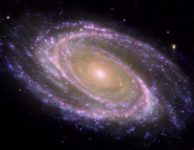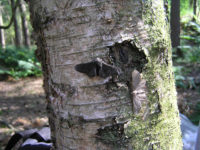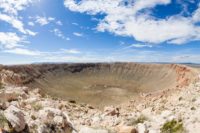By Creation Moments I was talking to a group of young children, perhaps 10 or 11 years old, and they were looking at a partly mud-covered house. This house had got covered in mud at the time of the 1980 eruption of Mount St Helens. Meanwhile, close by was a fridge, which had been washed out of the house, at the time of the mudflow. One boy was incredulous. read more …read more Source: Creation Moments
By Creation Moments Have angels always existed from eternity? The Bible says “No”. Only God, the One God in Three Persons, has existed for all eternity. So the angels and any other spirit beings that there might be must have been created by God. read more …read more Source: Creation Moments
By kpennock On this episode of ID The Future, Sarah Chaffee talks with physicist Dr. Brian Miller about a recent article that argues that the fundamental basis of the universe is information. In this episode, Miller explains how physicists have come to rethink the role of information, moving from a materialist view in which information is seen as a byproduct of matter to a view in which information is seen as fundamental to the fabric of the cosmos. Your browser does not support playing Audio, please upgrade your browser or find our podcast on podOmatic Download Episode …read more Source: [More]
By Sarah Chaffee On this episode of ID the Future from the vault, Casey Luskin sat down with Dr. Wolf-Ekkehard Lönnig to talk about Dr. Lönnig’s direct area of specialty: carnivorous plants. Dr. Wolf-Ekkehard Lönnig is a retired geneticist at the Max Planck Institute for Plant Breeding Research in Germany. Your browser does not support playing Audio, please upgrade your browser or find our podcast on podOmatic Download Episode …read more Source: id the future
By Creation Moments Today, I want to talk about aging stars. But I am not referring to your favorite movie icon of yesteryear. Instead, I am talking about stars in the universe. How old is a star? And how can we tell? read more …read more Source: Creation Moments
By Creation Moments Evolutionary geologists find ages for rocks, using a method known as radiometric dating. For example, uranium-lead dating relies on the change of uranium into lead. The rate at which uranium changes into lead is not linear, but can nevertheless be measured. This value is called the half-life. read more …read more Source: Creation Moments
By Creation Moments The half-life is a value which gives an indication of the rate of decay of radioactive isotopes. Radioactive decay occurs in an exponential, rather than linear way. Suppose an isotope, which we will call X, has a half-life of 1 year. If we have 32lb of X today, then in a year, we will have just 16lb – half of 32. In another year, however, we will lose only 8lb more—half of 16. read more …read more Source: Creation Moments
By Creation Moments In two previous Creation Moments, I have described how radiometric dating works, and how uranium changes into lead. We found that, for every atom of uranium that decays, eight atoms of helium are made. If a rock contained no lead when it was formed, then all the lead must have been made from uranium, and there would be 8 times as many helium atoms as lead atoms. read more …read more Source: Creation Moments
By Creation Moments Like many people of my generation, I was fascinated by the Apollo Moon landings from 1969 through 1972. As a small boy, I keenly watched all the special programs that I could on BBC TV. I clearly remember one of the BBC experts, signing off the Apollo 17 broadcast, by telling us that NASA would certainly have people on Mars before 1990. I waited eagerly, but it never happened. read more …read more Source: Creation Moments
By kpennock On this episode of ID The Future, Tod Butterfield talks with historian Dr. Richard Weikart about his new book Hitler’s Religion: The Twisted Beliefs that Drove the Third Reich. In this episode, Dr. Weikart explains how Darwinian evolution informed Hitler’s ethics. Your browser does not support playing Audio, please upgrade your browser or find our podcast on podOmatic Download Episode …read more Source: id the future
By Sarah Chaffee On this episode of ID the Future, Tom Woodward interviews CSC Senior Fellow John G. West on the radio show, The Universe Next Door. They discuss Michael Behe’s two decades of influence through Darwin’s Black Box, published in 1996, and the recent film detailing his story. Watch Revolutionary now, available for free online at www.revolutionarybehe.com. Your browser does not support playing Audio, please upgrade your browser or find our podcast on podOmatic Download Episode …read more Source: id the future
By Creation Moments There is a story about a man, who had a dog. A friend asked him what kind of dog it was. The man replied “He is a Heinz dog”. “I have never heard of a Heinz dog”, said the other. “Sure you have”, said the first. “He has 57 varieties”. read more …read more Source: Creation Moments
By Creation Moments Richard Dawkins believes he has found an organ system, which is badly designed, and so proves that no god could have designed it. He has popularized this accusation so widely that atheistic websites and forums simply quote the example, as if it were proven. He refers to the color receptors on the retina of the vertebrate eye. read more …read more Source: Creation Moments
By Creation Moments I often think that all Christians should be interested in astronomy. That does not mean that I think you should be experts in how stars work, or how light travels. But the Psalmist says that “the heavens declare the glory of God, and the sky above proclaims his handiwork”. read more …read more Source: Creation Moments
By Creation Moments Every so often, we need to return to the topic of peppered moths, which we have featured a number of times before. Previous Creation Moments have explained why Peppered Moths are not an example of evolution, and how, in the 1980s, it was found that the famous photos showing light and dark moths on light and dark tree trunks had, in fact, been staged. read more …read more Source: Creation Moments
By Sarah Chaffee On this episode of ID the Future, hear part 2 of a lecture given by David Snoke at a conference sponsored by the Christian Scientific Society. In this segment, Dr. Snoke, professor of physics and astronomy at the University of Pittsburg, discusses the relationship between information and entropy. Your browser does not support playing Audio, please upgrade your browser or find our podcast on podOmatic Download Episode …read more Source: id the future
By Creation Moments The Solar System has seen many impacts. On so many bodies of the Solar System, these impacts have produced craters. It is well known that the surface of the Moon contains many craters, which are thought to have been formed when a meteorite hit the Lunar surface. However, the Moon is not alone. read more …read more Source: Creation Moments
By kpennock On this episode of ID the Future, to celebrate Michael Denton’s newest book, The Wonder of Water, we bring you a conversation between Ray Bohlin and Howard Glicksman on the body’s wondrous control systems for using water. Dr. Glicksman is a medical doctor and author of an extended series of posts at Evolution News & Science Today, “The Designed Body.” Your browser does not support playing Audio, please upgrade your browser or find our podcast on podOmatic Download Episode …read more Source: id the future
By Sarah Chaffee On this episode of ID the Future, we continue to celebrate geneticist Michael Denton’s new book, The Wonder of Water, with this reposted interview where Denton reflects on the concept of bottom-up, versus top-down, causation, and which is the better explanation for the world we live in. Your browser does not support playing Audio, please upgrade your browser or find our podcast on podOmatic Download Episode …read more Source: id the future
By kpennock An actor in Hollywood raises the important question of when people should and shouldn’t be skeptical of claims made in the name of science, inspiring a response from political scientist John West, author of Darwin Day in America. This conversation was taped live in Hollywood during a discussion after the final performance of Disinherit the Wind, a play that tells the story of a neurobiologist who sues his university for the right to challenge neo-Darwinian evolution. Your browser does not support playing Audio, please upgrade your browser or find our podcast on podOmatic Download Episode …read more Source: [More]
By Creation Moments London’s famous Natural History Museum features an enormous gallery, where, among other large creatures, you can see a life-size blue whale hanging from the ceiling. read more …read more Source: Creation Moments
By Creation Moments One highly qualified British creationist scientist related to an audience how another scientist has approached him, to help with a course he thought their university should run, about the problems associated with evolution. My friend said he would be happy to help. A few days later, the other scientist returned sheepishly to my friend. He would not, after all, be able to run the course. read more …read more Source: Creation Moments
By Creation Moments When I was a science teacher, in government schools in England, I used to like to show a particular video to my classes. This video featured some unusual plants that had strange reproductive methods. The most unusual of all was the bucket orchid. read more …read more Source: Creation Moments
By Creation Moments It often surprises visitors to England, to see how close it is to the main road. Perhaps they imagine it should be remote, miles from civilization. However, when Stonehenge was built, whatever purpose it was built for, it was clearly at the center of civilization at the time. read more …read more Source: Creation Moments
By kpennock On this episode of ID The Future, Tod Butterfield talks with CSC Senior Fellow Dr. Richard Weikart about his recently published book Hitler’s Religion: The Twisted Beliefs that Drove the Third Reich. In particular, Weikart explores Hitler’s pantheism and his antipathy toward Christianity. Your browser does not support playing Audio, please upgrade your browser or find our podcast on podOmatic Download Episode …read more Source: id the future
By Creation Moments The devastating blast from the eruption of Mount St Helens, on May 19, 1980, tore down huge, mature trees. Old growth forest was flattened north of the volcano in an area covering 230 square miles. Trees were demolished up to 17 miles away. read more …read more Source: Creation Moments
By Sarah Chaffee On this episode of ID the Future from the vault, Stephen Meyer is on The Universe Next Door to discuss Thomas Nagel’s controversial book Mind & Cosmos: Why the Materialist Neo-Darwinian Conception of Nature Is Almost Certainly False. Nagel, a leading philosopher of science and a self-described agnostic, tells in his book how he has become disenchanted with the materialist worldview, and how science today leaves fundamental questions unanswered — such as the nature of mind and consciousness. Meyer also discusses the origin of animal body plans and the inference to design. Your browser does not support [More]

























